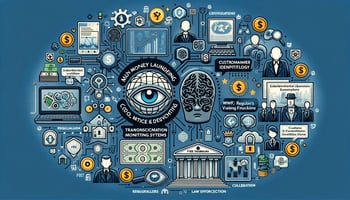The FEC domain, or the domain of Financial Economic Crime, focuses on detecting, investigating, and...
Anti-Money Laundering (AML): Comprehensive Overview
.gif?width=1280&height=720&name=Untitled%20design%20(1).gif) Anti-Money Laundering (AML) refers to the laws, regulations, and procedures aimed at preventing criminals from disguising illegally obtained funds as legitimate income. AML practices are critical for financial institutions and other regulated entities to detect and prevent money laundering activities.
Anti-Money Laundering (AML) refers to the laws, regulations, and procedures aimed at preventing criminals from disguising illegally obtained funds as legitimate income. AML practices are critical for financial institutions and other regulated entities to detect and prevent money laundering activities.
Key Components of AML
-
Regulatory Framework:
- Financial Action Task Force (FATF): An intergovernmental organisation that develops and promotes policies to combat money laundering and terrorist financing. FATF recommendations are widely adopted internationally.
- Bank Secrecy Act (BSA): U.S. legislation that requires financial institutions to assist government agencies in detecting and preventing money laundering.
- EU Anti-Money Laundering Directives: A Series of legislative acts by the European Union aimed at preventing the financial system from being used for money laundering and terrorist financing.
-
Know Your Customer (KYC):
- Customer Identification Program (CIP): Financial institutions must verify the identity of their customers by collecting and verifying personal information.
- Customer Due Diligence (CDD): Ongoing process of assessing the risk associated with a customer, including understanding the nature of their transactions and monitoring their activities.
- Enhanced Due Diligence (EDD): Additional scrutiny for higher-risk customers, such as politically exposed persons (PEPs) or individuals from high-risk jurisdictions.
-
Transaction Monitoring:
- Systems and software that monitor customer transactions in real-time or batch processing to detect suspicious activities or patterns that may indicate money laundering.
- Establishing thresholds for certain types of transactions that trigger alerts for further investigation.
-
Suspicious Activity Reporting (SAR):
- Financial institutions are required to file SARs with relevant authorities (e.g., Financial Crimes Enforcement Network (FinCEN) in the U.S.) when they detect transactions that appear suspicious or indicative of money laundering.
-
Record Keeping:
- Maintaining detailed records of transactions, customer identification, and due diligence processes. Typically, records must be kept for a minimum period (e.g., five years) as stipulated by regulatory requirements.
-
Internal Controls and Training:
- Development and implementation of internal policies and procedures to ensure compliance with AML regulations.
- Regular training programs for employees to recognise and respond to potential money laundering activities.
Key AML Procedures
-
Risk Assessment:
- Identifying and assessing the money laundering risks associated with customers, products, services, and geographic locations.
- Implementing a risk-based approach to prioritise resources and efforts towards higher-risk areas.
-
Client Onboarding and Ongoing Monitoring:
- Verifying the identity of new clients and understanding the purpose and nature of their relationship with the institution.
- Continuous monitoring of client transactions and behaviours to detect and investigate suspicious activities.
-
Reporting and Filing Requirements:
- Filing Currency Transaction Reports (CTRs) for transactions exceeding a certain threshold (e.g., $10,000 in the U.S.).
- Filing SARs when suspicious activity is detected, detailing the nature of the suspicious transaction and the reasons for suspicion.
AML Enforcement and Penalties
-
Regulatory Enforcement:
- Regulatory bodies such as FinCEN, the Financial Conduct Authority (FCA) in the UK, and the European Banking Authority (EBA) enforce AML regulations and conduct examinations of financial institutions.
- Non-compliance can result in substantial fines, sanctions, and legal actions against both institutions and individuals.
-
Penalties for Non-Compliance:
- Financial penalties: Significant fines for institutions failing to comply with AML regulations.
- Legal actions: Criminal charges against individuals involved in facilitating money laundering.
- Reputational damage: Loss of customer trust and damage to the institution's reputation.
International Cooperation and Initiatives
-
Egmont Group:
- A global network of Financial Intelligence Units (FIUs) that facilitates cooperation and information exchange to combat money laundering and terrorist financing.
-
United Nations Office on Drugs and Crime (UNODC):
- Works globally to assist countries in implementing AML measures and provides technical assistance and training.
-
International Monetary Fund (IMF) and World Bank:
- Provide guidance and support to countries in strengthening their AML frameworks and ensuring effective implementation.
Challenges in AML
-
Evolving Techniques:
- Money launderers continuously develop new methods to evade detection, requiring AML programs to be adaptive and innovative.
-
Technological Advancements:
- Cryptocurrencies and other digital assets present new challenges for AML due to their potential for anonymity and rapid transaction speeds.
-
Global Coordination:
- Differing AML regulations and enforcement across jurisdictions can complicate international cooperation and compliance efforts.
Conclusion
Effective AML practices are crucial for safeguarding the financial system from abuse by criminals and terrorists. It requires a comprehensive approach involving robust regulatory frameworks, advanced technology, continuous monitoring, and international cooperation. Financial institutions must remain vigilant, adaptable, and proactive in their efforts to combat money laundering and comply with evolving AML regulations.



